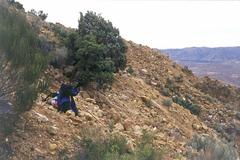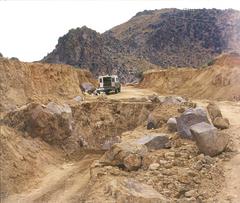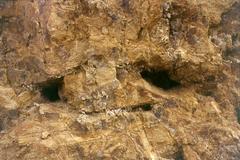last modified: Saturday, 03-Jun-2023 21:40:59 CEST
Document status: usable, almost complete
The name is obviously derived from its brown to gray color. Very dark smoky quartz is called
Morion. In Scotland, smoky quartz from the Cairngorm mountain range in the Scottish Highlands was used in jewelery and the stones accordingly were called
Cairngorms.
Not all quartz that is brown, gray, or black is called smoky quartz (see "Specific Properties").
In jewelery, faceted smoky quartz used to be sold as "smoky topaz". I don't know if that is still common practice, but as far as I know the traders codex does not allow this anymore.
It is interesting that as long a colorless glass was a precious good, smoky quartz was considered as being of less value than the clear rock crystal.
Specific Properties
The
color of smoky quartz is caused by irradiation and traces of aluminum built into its crystal lattice. Aluminum replaces silicon to form a [AlO
4]
- group instead of [SiO
4]. To compensate for the imbalance of charge in the lattice, small monovalent cations (H
+, Li
+ or Na
+) are built into the lattice, as well. High energy radiation transfers the extra electron from [AlO
4]
- to the cation, and a
color center is formed. Interestingly, H
+ seems to interfere with this process, and higher concentrations of built-in hydrogen inhibit the formation of color-centers
[1]. In normal geological environments this process can only take place at temperatures below 50°C, otherwise the rate of color center destruction surpasses that of color center formation. So the color of the crystals appeared long
after the crystals have grown. It is estimated that it takes several million years for a crystal to assume a deep color in a granite of average composition.
Sometimes it is said that it is the high energy cosmic radiation that causes the coloration and not the radiation from radioactive sources. At least for alpine quartz, this is very unlikely. There are reports about alpine vugs in which both smoky quartz and rock crystals have been found (e.g. ->Rufibach and Martin). Calcite grew on some of the crystals and shielded them from the radiation coming from the surrounding rocks. Cosmic radiation that penetrated the entire mountain would definitely not be stopped by a layer of calcite.
In addition, quartz from Arkansas, for example, is laying in the ground for quite some time (about 200 million years) and should already be at least a little smoky. Although it can easily be turned into smoky quartz by artificial irradiation, the quartz found there is colorless.
The color of smoky quartz is typically much more homogeneous than that of amethyst, but often still more intense at the tips of the crystals. Crystals that show a zonar or patchy coloration are not uncommon, however, and often these are most intensely colored at the edges between the rhombohedral faces. Sometimes a dark color is caused by impurities like organic compounds or manganese oxide, but those rocks should not be called "smoky quartz". That name is reserved for quartz whose color has been induced by radiation.
True smoky quartz will loose its color when heated to about 200°C, and the color will occur again when the crystal is irradiated with x- or gamma-rays. Smoky quartz is sensitive to ultraviolet light and will pale when exposed to sunlight for a long time.
At some locations smoky quartz shows zones of violet or yellow color along with smoky ones. The different colors might be found in different layers as "phantoms", or they show a patchy distribution in one crystal.
Smoky quartz is dichroic and shows a change of color from yellow-brown to red-brown when turned around an a-axis in polarized light (see Physical Properties for an explanation).
Smoky quartz basically appears in the same crystal habits (e.g. long- or
short-prismatic, platy, as scepters, with trigonal habit, or as skeleton quartz), and crystal forms (determined by the type of crystal faces that appear on a crystal) as rock crystal. Skeleton quartz and needle quartz seem to be an exception, they both are fast-growing forms and the latter in particular for some reason in most cases doesn't darken upon irradiation. A growth form that is very often smoky is the gwindel, because these apparently only grow in igneous and highly metamorphosed rocks, and usually grow very slowly.
It's still common practice to artificially irradiate colorless quartz and sell it as smoky quartz. On big fairs, dealers are obliged to clearly label that quartz accordingly, but it's impossible to tell whether the source of the irradiation was natural or not just by looking at the crystals, so some dealers don't do that and get away with it. In the U.S.A. a lot of produce gets irradiated with gamma rays as a means of sterilization, and a box of white quartz just needs to be put on the same conveyor belt as the tomatoes for a couple of times. Often the dealers overdo it and the crystals turn out suspiciously black.
The
only hints to tell if a specimen was irradiated are its origin and the geological environment it grew in. The latter requires a piece of matrix. Deeply colored, almost black quartz usually only occurs in igneous rocks. Gangue quartz is rarely black (at least I have never seen it), so you should raise your eyebrows over black quartz along with galenite or pyrite.
The location is often more helpful. A typical example is Arkansas. There is natural smoky quartz from Arkansas, but it is rare, and thus will not be sold by the lot on a fair. Anything smoky you get from Arkansas is irradiated. The specimen to the right probably was a little cloudy inside, and it also has a lot of little crystals grown on the prism. So it received some treatment, and voila, what a nice piece you get. Occasionally there's a picture of a "smoky quartz" from Arkansas in a book to serve as an example for a typical smoky quartz.
Another
example is artichoke quartz from Romania (shown in the next picture). In 2004 I got a black one at the Hamburg mineral fair, and though some people said they were "bestrahlt", I thought, hmm, you never know, it's cheap, and before I miss something... Of course, the others were right. It is covered with small dolomite crystals on the back side. From Cavnic, Maramures, Romania.
Occurrence
Smoky quartz is usually found in intrusive igneous and certain high grade metamorphic rocks, like granite and orthogneiss, as these contain traces of radioactive elements whose radiation cause the coloration.
Smoky quartz from volcanic rocks is more uncommon, here amethyst and colorless quartz dominate.
Smoky quartz from sedimentary rocks is very unusual. Their content of radioactive elements is usually very low[2]. Much of the "smoky" quartz reported from sedimentary rocks is actually not true smoky quartz, but quartz containing black or brown inclusions.
Gangue quartz found at ore deposits is usually colorless or only slightly brown.
As mentioned above, it takes a long time for smoky quartz to assume a deep color, and this requires temperatures below approx. 50°C. So even if the host rock is radioactive, the rock must have been uplifted into low temperature zones for some time before the rock crystals turn smoky. That's the reason why in many areas in the Alps smoky quartz and especially morion is only found at high elevations - these parts of the mountains have been at the (cool) surface for about 2-8 million years longer than the rocks in the valleys.
Locations and Specimen
Austria
I've
bought this specimen from a Strahler in the Virgental in Tyrol, but unfortunately not from him personally, so I don't know its exact origin.
China
Smoky
quartz with spessartine garnet, Wushan Spessartine Mine, Tongbei, Yunxiao County, Zhangzhou, Fujian, China.
This
"winter landscape" - smoky quartz partially covered by calcite crystals - is really remarkable, but the first question that comes to mind is "is it irradiated?". Very likely. The quartz is probably from some gangue ore deposit, as I could see traces of pyrite on the bottom of the crystals, and quartz from these environments is usually not that dark. The specimen is from the Yaogangxian Mine, Hunan Province, and members of a rockhounding web forum said smoky quartz from that location is irradiated.
Smoky
quartz in its natural habitat - pockets in granite. This specimen from Hu Jiang shows transparent and evenly colored smoky quartz crystals along with much smaller orthoclase and muscovite crystals on a thin slab of granite. The crystals do originate from crystals inside the granite but seem to be concentrated along a line, possibly a crack that was filled with quartz. Some of them show rarer crystal faces like steep rhombohedra, but unfortunately the crystals are partially covered with fine pocket detritus (the cause for the gray outline at the crystals to the left).
Germany
This
is an example for smoky quartz from a sedimentary rock. It comes from a limestone/dolomite quarry near Medenbach, Hessen, Germany. I've done a test on another specimen from the same location, and as it paled upon heating, one may assume it's true smoky quartz. The specimen is not different in appearance from the typical quartz you find in many limestone and dolomite quarries in the Rheinische Schiefergebirge, e.g. in being heavily twinned, short-prismatic, translucent, showing an onion-like layered internal structure, and often being double terminated. But it got its dose of irradiation, perhaps from radioactive trace elements in waters rising from the nearby Westerwald volcanoes.
This
is a piece of a geode that weathered out of the basalt in the Juchem quarry, Niederwörresbach. That location in the Idar-Oberstein region is more famous for agate and amethyst but as you can see, it is also possible to find dark smoky quartz in a volcanic rock.
Usingen
in the Taunus mountains is a very famous quartz location in Germany. The quartz occurs in large hydrothermal veins and is mined in quarries for use in the glass manufacture. Quartz crystals (smoky and milky) usually occur in aggregates and typically lack prism faces, often they show artichoke growth forms, like the specimen on the image. Phantoms are very common.
Usingen
is also well known for its "Kappenquarz" (capped quartz), crystals that are more or less easily split along the borders of their internal phantoms. These capped quartz specimen look much like the banded smoky quartz in the image that would probably qualify as a
coon tail quartz in American literature.
Another,
very typical smoky quartz specimen from Usingen in the Taunus mountains, north-east of Frankfurt. The crystals lack prism faces (m-faces) and only show rhombohedral faces. All crystals show a zonar smoky color, forming multiple phantoms. Also shown at the
Phantom Quartz paragraph of the
Growth Forms section.
During
road works near Bad Brambach in Sachsen (Saxony), a lot of of quartz veins in granite were cut open, and local collectors retrieved a large number of smoky quartz specimen from pockets inside the elongated, vertical veins between 1999 and 2002 (
Woldert, 2002). The area was already known for frequent finds of smoky quartz crystals (
Roth, 1994). This specimen is just a small but rather typical sample, with a wreath of small crystal surrounding the base of the larger, slightly smoky crystals. Many specimens are covered with a tough crust of brown limonite.
Greece
In northern
Greece, the Kato Nevrokopi basin at the southern slope of the Rhodope mountains is a source of quartz crystals that resemble those found in the central Alps and that come from alpine-type fissures. Those on the image are two intergrown dark and clear, double-terminated smoky quartz crystals that suffered mechanical damage: during growth a large part of the tips broke off and left a large step in it that cuts obliquely through the larger crystal and that was healed by many small crystal tips sprouting from it. The surface structure of these crystals indicates an internal
macromosaic structure that is typically found in crystals that grew slowly at high temperatures. The large rough triangular patch at the left lower end is an x-face that also indicates slow growth and high temperatures. Donated by Anastasios Tsinidis.
Italy
The
northeastern part of Sardinia (a landscape called Gallura) is largely made of granite in which smoky quartz is occasionally found in miarole and pegmatite pockets. The Isola La Maddalena, in particular the Cala Francese quarry at its western coast is a well known source of smoky quartz and other pegmatite minerals, but the entire island is now a nature preserve and strict regulations apply. You can find out more about that location and its minerals in this nice
->book , albeit in Italian. There is also a web site covering minerals and geology of the Gallura:
http://www.geomine.it.
This specimen comes from a small pocket that I found near an aplitic dyke in the macchia at the holiday resort of Baja Sardinia, Arzachena. I was actually not after minerals at all but just climbing for fun through the granitic domes when I stumbled over a large part of a quartz prism. The next day I extensively searched the vicinity and finally found a small open pocket with a few smoky crystals, orthoclase, muscovite and epidote.
Another
crystal that shows a white cap because of internal cracks. The olive green crystals on its front prism face are epidote.
A
last group of parallely intergrown smoky quartz crystals from the same pocket.
Malawi
Smoky
quartz of transitional habit on microcline from Mount Malosa, Zomba District. The shiny faces are steep rhombohedral faces, the rough faces left and right to them are
x faces.
Another
smoky quartz specimen on creme-colored orthoclase feldspar crystals from the Chilwa Alkaline Area at Mount Malosa. The crystals contain black and white needles of undetermined minerals, the black ones could be aegirine.
Morocco
A
very nice piece, undamaged, large, and transparent, that I got from a Moroccan trader, however I could not find anything more about its origin than "Morocco" (maybe Ambatolehime?). It has a number of interesting crystal faces and is a Dauphiné twin - its morphology is discussed in the
Crystal Twinning section.
Namibia
Smoky
quartz crystals on feldspar from a miarole pocket in granite in the western Erongo mountains. The crystals show a transitional habit, and because they are double terminated, their prisms are barrel-shaped. The distribution of the smoky color is a bit unusual, as it is mostly concentrated in a central layer that lies parallel to the c-plane. This is true for all the crystals on the specimen, but on the image this can only be seen in the large crystal in the front. Some of the crystals also include a few tourmaline needles.
These
stubby smoky quartz crystals, also from a granite miarole pocket in the western Erongo mountains, show thin cloudy inclusions in the outer layers.
Morion
and feldspar crystals from a miarole pocket in the western Erongo mountains. Until recently, well-formed and dark smoky crystals were not that common at the Erongo.
Norway
There
are a number of smoky quartz locations in igneous rocks in southern Norway, especially in the area west of the Oslo Fjord. The picture shows a morion from Drammen, Norway. It has a nice "Tessin" habit.
Smoky
quartz crystals from Sørli, Nord-Trøndelag, sometimes show a peculiar surface pattern on their prism faces that is caused by split growth and an asymmetric distribution of debris on the surface, like the one on the image. Note that the right rhombohedral face is shiny and the left one is rough. The color in these crystals is not even but concentrated in thin phantom-like zones.
This
is a photo of the same specimen, turned clockwise by 60°, that shows the asymmetric distribution of debris which preferrably precipitated on the left side of the specimen (see also the discussion in
Crystal Habits).
Romania
This
specimen is from Romania, has most likely been irradiated to assume a dark color. The color is a bit yellowish, probably due to inclusions, as it is from an ore deposit.
You can see a few pyrite cubes at the base of the specimen. The crystals are grown as artichoke quartz, and this is very typical for quartz from Romanian ore mines. The same specimen is presented at the "growth form" section.
Switzerland
Switzerland, of course, is
the classical location for smoky quartz. Smoky quartz from the Alps is generally found in so-called
alpine-type fissures (also called "alpine-type clefts"), in particular from granites and gneisses, as these rocks carry enough radioactive elements to cause an irradiation-induced smoky quartz formation. Interestingly, even in these rocks, smoky quartz is mostly found at altitudes above 2500 m, crystals in lower areas tend to be less colored or even colorless. The likely reason for this is the fact that smoky quartz color centers are not stable at temperatures above about 50°C and the crystals must have been subject to irradiation at lower temperatures for a sufficiently long time. Since the crystals grew at rather high temperatures about 10 km below the surface, the fissure-bearing rock had first to be uplifted und cooled before the color centers remain stable. Rocks at the valley floor have not been cooled as long as the rocks at high altitudes.
This
is a very nice example of a normal habit smoky quartz as it is found in the southern Aar Massive of central Switzerland. It is a crystal with the
macromosaic structure typically seen on almost all smoky quartz crystals from the Aar and Gotthardt Massives. From the Feldschijen, Turm I (first tower of Feldschijen mountain), Göschenen, Uri, Switzerland.
The
specimen to the right came from the Gotthardt region in the central Alps, the dealer said it's from the Gotthardt tunnel. This is very unlikely: various sources report that during the works on the tunnel only clear rock crystal was found. The explanation given is that the time since the temperature has fallen below 50°C was not sufficient for the coloration to occur. The temperatures inside the mountain during the tunnel excavations still exceeded 30-40°C. Smoky quartz can be found at greater altitudes in the same mountain range, however, and that's where it is probably from.
This
is a light colored smoky quartz from the Ofenhorn, at the eastern end of the Binntal. Crystals that get narrower towards the tips because of steps of rhombohedral faces are sometimes called
Babylon quartz.
Clear
smoky quartz crystals with adularia (hydrothermally grown orthoclase) and amiant (hair-like actinolite) on a quartz-monzonite matrix (a granitoid igneous rock commonly called "Giuv Syenite") from the Val Giuv in Graubünden. Val Giuv, about 20 km east of the Gotthardt tunnel, is a classical location for smoky quartz and gwindel of exceptional clarity and color. The valley has one of the highest densities of alpine-type fissures in the world.
The large crystal in the image is clear all the way down to its base. It is probably a "left quartz", as indicated by three triangular x-faces, of which one can be seen. The x-face can be found on many crystals from that location and is probably indicative of slow growth. The crystals typically show a normal or prismatic habit, as most quartz from the central Swiss Alps.
A
small, perfectly clear smoky quartz crystal from the same location as the former one, that shows a very large x-face, along with an s-face (the small bright bar to the right), steep rhombohedra, and an additional, dull trapezohedral face, perhaps the u-face, between x and s. The crystal is untwinned, even though the sutures running through the crystal make it appear so. These sutures reflect the internal
macromosaic structure, which is also typical for slow growth.
A
group of small smoky quartz crystals that are directly attached to the rock wall of the alpine-type fissure, a quartz-monzonite ("Giuv Syenite"). The clear crystals carry a thin icing of chlorite flakes that have mostly settled on the triangular x-faces. This specimen is also from the Val Giuv.
A
smoky quartz specimen from Val Giuv. The crystal faces show a silken shine because of numerous superficial indentations of a now dissolved mineral. Private Collection Switzerland.
Ukraine
Perfectly
black morion has been found in pegmatite pockets at Volodarsk-Volynskii, Zhytomyr Oblast. This crystal is almost opaque. The crystal is an ideally developed Dauphiné law twin, with large left-handed x-faces (selectively brightened by reflectors) on all prism faces. Spirifer Collection, Poland.
U.S.A.
Very good smoky quartz comes from the Pikes Peak region in Colorado, pictures of specimen with morion on blue-green amazonite crystals can be frequently seen in magazines.
Peterson Mountain (also called
Petersen Mountain) lies on the California-Nevada border at the eastern slope of the Sierra Nevada north of Reno and is one of the best known quartz localities for rockhounds in Nevada and California (the spot is also known as
Hallelujah Junction, named after the nearby highway junction). One can find smoky quartz and amethyst, sometimes of very good color.
Figure 1 shows the location from the Californian side; the rim of the mountain is already in Nevada. What you see is actually just a small part of Peterson Mountain near to its northern end. The most promising areas are studded with small private claims and on the weekends you will always find a few rockhounds who camp out at the foot of the mountain. So the chances of picking something up without hard work and some digging are somewhat dim, as you can tell from Fig. 2 and 3. The yellow sign in Fig. 3 marks a private claim.
There is a larger claim on top of the mountain (Fig. 4, already in Nevada), whose owner Foster Hallman will guide groups through his claim and let them dig for a fee.
Peterson Mountain consists of bright colored granite, just like the surrounding mountains who are void of crystals, but it is situated on a fracture zone and has been tectonically very active. Two emptied pockets (about 20-50 cm wide) in a wall of that claim can be seen in Fig. 5. The granite does not show any signs of boudinage, as it is typical for alpinotype vugs, but appears shattered and cut by numerous quartz veins in random directions. These quartz veins occasionally widen up to crystal bearing pockets.
Many
of the crystals at Peterson Mountain have developed scepters and are multicolored, typically smoky with zones of amethyst coloration. The smoky quartz scepter on the picture also has a few very faint amethyst color zones which cause the scepter to have a reddish overall tone in its color. Note that the smoky color is not evenly distributed and concentrated at the edges of the prism and along the edge of the bottom end of the scepter. By the way, this is not a dent at the tip of the scepter, it is a growth pattern that can sometimes be seen on wide crystals. The scepter was found on the central part of the slope on the Californian side.
This
dark smoky quartz crystal from Peterson Mountain has a smooth surface, but you can see that during its growth it has once been subject to external mechanical forces: just under its surface a lot of dings and dents have been embedded as a record of the destructive tectonic activity at the Peterson Mountain fault.
Smoky
quartz
epitactically intergrown with microcline feldspar, var. amazonite, from Conway, New Hampshire. The standard example for epitactical growth of crystals of one mineral in another is
graphic granite, in which smoky quartz crystals of identical orientation sit in a feldspar matrix and form a pattern that resembles a written text in primitive letters. The intergrowth is law-like: the axes of the quartz crystals are oriented in a specific angle with respect to the axes of the feldspar crystals. Graphic granite is frequently found in the transition zone from a pegmatite body to the surrounding granite. It is rather uncommon for these smoky quartz crystals to poke out of a well terminated feldspar crystal to form shiny points, as in this specimen.
Further Information, Literature, Links
Footnotes
1
I would
speculate that this is so because the proton H
+ does not have an electron shell anymore and is "swallowed" by one of the sp
3 hybrid orbitals of oxygen in the negatively charged [AlO
4]
- group to form a neutral [AlO
4H], very similar to the formation of NH
4+ from NH
3. This would not work with Li
+ or Na
+, as they are still surrounded by electrons.
2
Uranium is a very "mobile" element, however, and is occasionally found in sedimentary deposits which it entered in hot rising solutions from igneous rocks.
3
The temperature falls due to an uplift of the mountain range. The rocks that are now visible at the surface originate at depths of 10km or more.
 Printer Friendly Version
Printer Friendly Version
Copyright © 2005-2022, A.C. A k h a v a n
Impressum
- Source: http://www.quartzpage.de/smoky.html


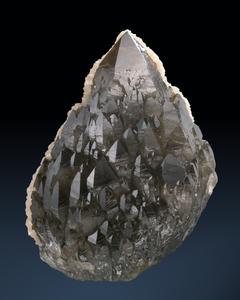
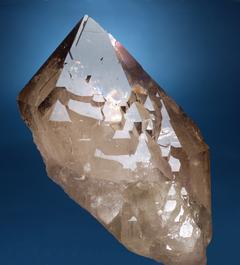
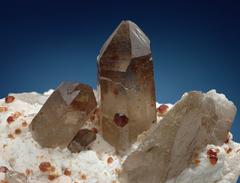

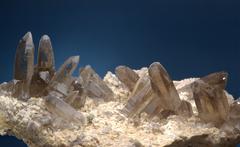



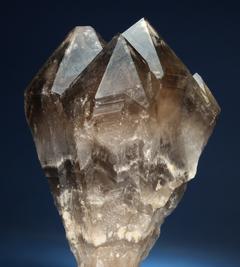
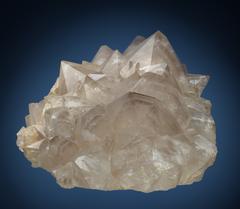

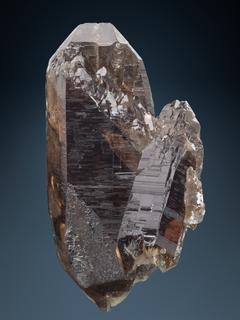

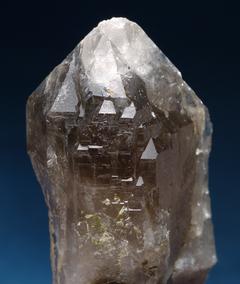
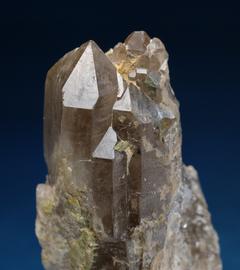
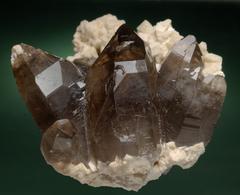
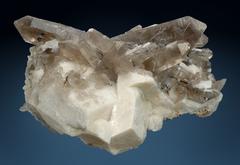
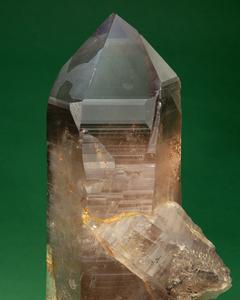
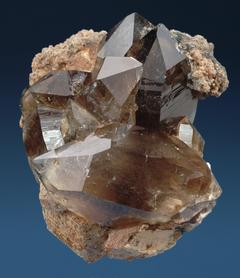
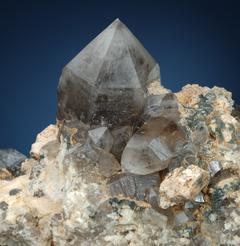
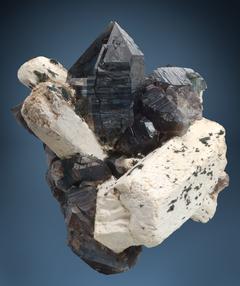
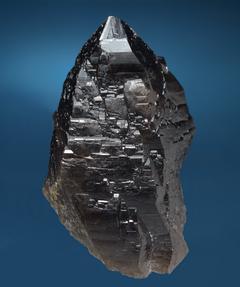
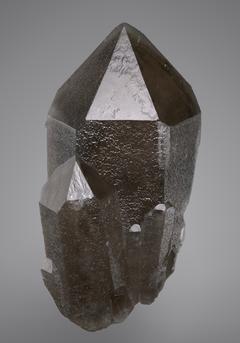
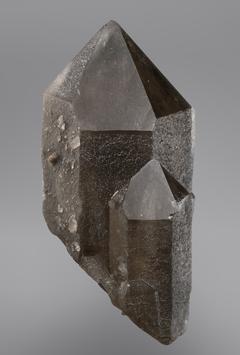
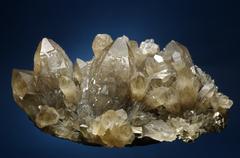

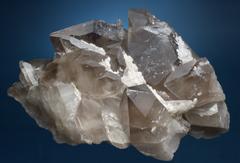
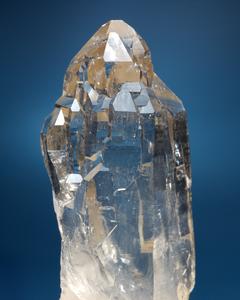


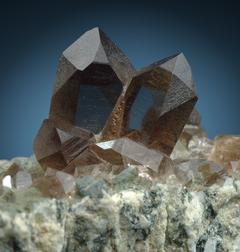

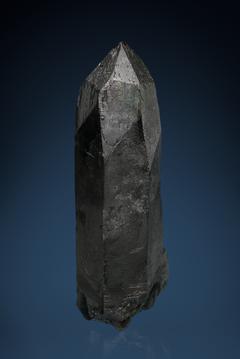
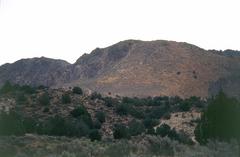


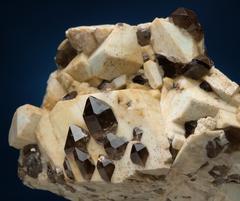
 Printer Friendly Version
Printer Friendly Version
